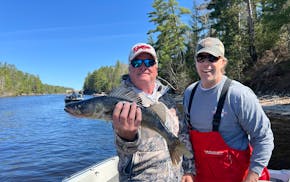In Minnesota, big lakes mean big fish, and lots of them.
And big money, too.
According to the Department of Natural Resources, the state's 10 largest inland lakes feature a combined surface area of 825,000 acres and produce about 40% of Minnesota's annual walleye harvest.
These lakes — and their walleyes — also account for the bulk of the approximately $2.4 billion spent each year on fishing in Minnesota.
So important are these waterways that the DNR assigns a fisheries specialist to each. And every fall, the agency gauges each lake's productivity so bag limits and other restrictions can be adjusted, if necessary.
Going fishing on the opener or later this summer?
These lake profiles might get you hooked on Minnesota's "Big 10."
Winnibigoshish: With a six-walleye limit, this 67,000-acre gem is a rarity among large Minnesota lakes. Walleyes caught in DNR fall survey nets declined some in recent years before leveling off. The 2020-2022 classes were average or below. But the 2023 class was better, with walleyes measuring about 10 inches showing up in last fall's survey. Dan Schermerhorn of the DNR expects fishing to be good on the opener, as it has been in recent years, though some walleyes from the 2019 year class — the biggest in recent history — will have grown into the 18- to 23-inch protected slot (one over 23 inches is allowed). Meanwhile, Winnie's perch are coming back, with record high catches of young perch recorded in recent surveys.
Kabetogama: "Kab will be an excellent walleye destination again this summer. Catch rates during DNR fall surveys have been good the past three years," said Ben Vondra of the DNR, with the 2020 class especially strong. Those fish are now 13 to 16 inches and will provide a significant share of anglers' catches on the state's May 10 fishing opener. Kab's 26,000 acres are governed by a four-walleye limit with an 18- to 26-inch protected slot (one is allowed over 26 inches). With 200 islands and more than 500 miles of shoreline, Kabetogama is a good — and scenic —early-season walleye fishery.
Mille Lacs: Mille Lacs will in all likelihood welcome boatloads of anglers beginning with the opener, thanks to a two-walleye limit set by the DNR. Both walleyes must be over 17 inches, with only one longer than 20 inches. The less good news is that the lake's yellow perch are abundant, which likely will provide competition this summer for anglers' baits. The 2013 class that dominated Mille Lacs for so many years is aging. But 2017 and 2021 produced good numbers of walleyes, said Eric Jensen of the DNR, which will provide a wide range of fish for Mille Lacs anglers to target. Anglers this past winter caught a lot of walleyes from the abundant 2024 class. These "quarter pounders" will continue to nibble anglers' bait this summer.
Leech: Walleyes caught in DNR fall survey nets have been within target ranges for Leech in recent years, affirming the productive fishing anglers have found on this 112,000-acre lake. The ice went out on Leech about a week ago, and the lake's DNR specialist, Carl Pedersen, expects walleyes will be in a biting mood on opening weekend. Though the good 2019 walleye class is aging, the 2021 class was strong, and the 2023 class was better than expected. Leech anglers are allowed four walleyes, with one over 20 inches, a generous regulation. Anglers should note that Leech's historically abundant perch are making a comeback, with strong catches this past winter and jumbos showing up regularly.
Rainy: Rainy features a great walleye fishery, but not one typically known for its fish-catching fireworks on the opener, in large part due to its northern location. Offering anglers a wide range of walleye sizes, Rainy experienced a productive 2019 class and an even stronger 2021 class. With four walleyes allowed, including one over 26 inches, and those within an 18- to 26-inch slot protected, anglers in the season's first few weeks will find some of Rainy's post-spawn fish in shallow bays and along windward shores. As the water warms, these fish will move to the lake's many reefs and underwater humps, where some of the lake's biggest walleyes, 30 inches and more, will lurk.
Upper Red: With a five-walleye summertime limit (only one can be longer than 17 inches) set by the DNR, Upper Red is expected to again be the state's opening-weekend walleye hot spot. A strong 2019 class likely will produce anglers' one fish over 17 inches, while a similarly strong 2022 class will provide keepers — if not on the opener, then as the summer progresses and these fish grow. The DNR could have set a four-walleye limit on Upper Red this summer, with one allowed over 20 inches. But the agency opted for the five-fish option. "Anglers will find walleyes of all sizes," said the lake's DNR fisheries manager, Tony Kennedy.
Lake of the Woods: This 951,000-acre (317,000 in Minnesota) paradise is well known for its world-class fishing, and the lake boasts above-average catch rates for keeper-sized walleyes. As a bonus, saugers are abundant, and this summer, they'll help fill anglers' live wells. LOW's walleye-sauger combo limit is six, no more than four of which can be walleyes, with those between 19½ and 28 inches protected. Recent DNR fall surveys confirm angler reports that walleyes up to 17 inches are plentiful, while fewer older walleyes are in the mix, said fisheries manager Mike Wolf of the DNR. An extremely healthy fishery, Lake of the Woods produced a strong 2021 walleye class, while saugers had banner production in 2014, 2017, 2019 and 2022.
Pepin: Minnesota's southernmost big-lake walleye fishery, a wide spot in the Mississippi River, Lake Pepin is home to one of the state's most interesting fisheries. In winter and spring, many of its walleyes swim up the Mississippi toward Red Wing, where they're pursued by bundled-up anglers (the walleye season is continuous on the Mississippi). In late spring, these fish fall back toward Pepin, where anglers often opt for bottom bouncers and shiners or fatheads. Nick Schlesser of the DNR reports that saugers will help fill anglers' combined four-fish limits this summer, adding that Lake Pepin walleyes must be at least 15 inches, with only one walleye or sauger allowed over 20 inches.
Vermilion: A pine-surrounded, 24-mile-long lake that stretches between the small towns of Tower and Cook, Vermilion for many years was known for walleye populations that varied in abundance between its east and west ends. That's less true now, said Matt Hennen of the DNR, citing recent fall survey results that show walleye numbers as generally the same on both ends. Years 2017 and 2020 yielded relatively weaker classes of Vermilion walleyes, but 2018 and 2021 were "really good," Hennen said. Beginning with the opener, anglers will find walleyes in a variety of sizes, including an influx of 13-inchers as the summer progresses. Vermilion is governed by a four-walleye limit, with a 20- to 26-inch protected slot and one walleye allowed over 26 inches.
Cass: Like Lake Winnibigoshish, Cass is governed by a generous six-walleye limit. But Cass Lake has no slot, just the statewide walleye restriction that allows only one longer than 20 inches. Including Cass Lake, a total of eight lakes make up the Cass Chain of Lakes, through which the Mississippi River flows. A productive walleye lake, Cass is often outshown as an angler destination during the first few weeks of the season, when smaller lakes in the chain tend to offer more action. By early June, however, the walleye bite often returns to Cass, and this summer, anglers will find good numbers of 15-inch walleyes, with 17- to 20-inchers mixed in. And big walleyes? The largest caught during a Cass tourney last October weighed 6 pounds, 15 ounces.
Anderson: Punish poachers more
Anderson: The Chainsaw Sisters Saloon is gone, but the Echo Trail is still a pathway to possibilities

Anderson: Crane Lake gives up its walleyes — and its memories
Anderson: Minnesota's million anglers should be convinced that Boundary Waters is worth protecting

